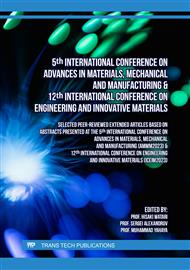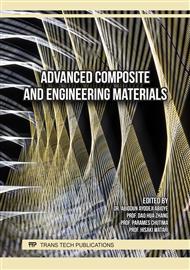[1]
I. Pleşa, P. Noţingher, S. Schlögl, C. Sumereder, and M. Muhr, "Properties of Polymer Composites Used in High-Voltage Applications," Polymers, vol. 8, no. 5, p.173, Apr. 2016.
DOI: 10.3390/polym8050173
Google Scholar
[2]
S. Yu, X. Li, Y. Zhao, and M. Zou, "A Novel Lightweight Polyurethane Composite for Application on Ultra-High-Voltage Insulator Core Filler," Polymers, vol. 12, no. 11, p.2737, Nov. 2020.
DOI: 10.3390/polym12112737
Google Scholar
[3]
M. Z. Saleem and M. Akbar, "Review of the Performance of High-Voltage Composite Insulators," Polymers, vol. 14, no. 3, p.431, Jan. 2022.
DOI: 10.3390/polym14030431
Google Scholar
[4]
R. Sekula, K. Immonen, S. Metsä-Kortelainen, M. Kuniewski, P. Zydroń, and T. Kalpio, "Characteristics of 3D Printed Biopolymers for Applications in High-Voltage Electrical Insulation," Polymers, vol. 15, no. 11, p.2518, May 2023.
DOI: 10.3390/polym15112518
Google Scholar
[5]
X. -R. Li et al., "Analysis of Morphology and Electrical Insulation of 3D Printing Parts," 2018 IEEE International Conference on High Voltage Engineering and Application (ICHVE), Athens, Greece, 2018, pp.1-4.
DOI: 10.1109/ICHVE.2018.8642096
Google Scholar
[6]
V. Petr, T. Tichý, O. Sefl, and E. Horynová, "Evaluation of dielectric properties of 3D printed objects based on printing resolution," in IOP Conference Series: Materials Science and Engineering, vol. 461, no. 1, p.012091, 2018.
DOI: 10.1088/1757-899x/461/1/012091
Google Scholar
[7]
L. Grassia et al., "Thermal and Dielectric Properties of 3D Printed Parts Based on Polylactic Acid Filled with Carbon Nanostructures," Macromol. Symp., vol. 405, p.2100244, 2022. [Online]. Available:.
DOI: 10.1002/masy.202100244
Google Scholar
[8]
F. Ebrahimi and H. R. Dana, "Poly lactic acid (PLA) polymers: from properties to biomedical applications," Int. J. Polym. Mater. Polym. Biomater., vol. 71, no. 15, pp.1117-1130, 2022.
DOI: 10.1080/00914037.2021.1944140
Google Scholar
[9]
J. Song, L. Wu, and Y. Zhang, "Thermal conductivity enhancement of alumina/silicone rubber composites through constructing a thermally conductive 3D framework," Polym. Bull., vol. 77, pp.2139-2153, 2020.
DOI: 10.1007/s00289-019-02839-3
Google Scholar
[10]
R. Han, Y. Li, Q. Zhu, and K. Niu, "Research on the preparation and thermal stability of silicone rubber composites: A review," Composites Part C: Open Access, vol. 100249, 2022.
DOI: 10.1016/j.jcomc.2022.100249
Google Scholar
[11]
Y. Liu, J. Lu, and Y. Cui, "Improved thermal conductivity of epoxy resin by graphene–nickel three-dimensional filler," Carbon Resources Conversion, vol. 3, pp.29-35, 2020.
DOI: 10.1016/j.crcon.2019.12.003
Google Scholar
[12]
M. B. Neǐman, B. M. Kovarskaya, L. I. Golubenkova, A. S. Strizhkova, I. I. Levantovskaya, and M. S. Akutin, "The thermal degradation of some epoxy resins," J. Polym. Sci., vol. 56, no. 164, pp.383-389, 1962.
DOI: 10.1002/pol.1962.1205616408
Google Scholar
[13]
M. T. Nazir, F. T. Butt, H. Hussain, B. T. Phung, S. Akram, M. S. Bhutta, and G. Yasin, "Physical, Thermal and Partial Discharge Evaluation of Nano Alumina Filled Silicone Rubber in an Inclined Plane Test," CSEE J. Power Energy Syst., vol. 8, no. 4, pp.1242-1249, 2020.
DOI: 10.17775/cseejpes.2020.01190
Google Scholar



